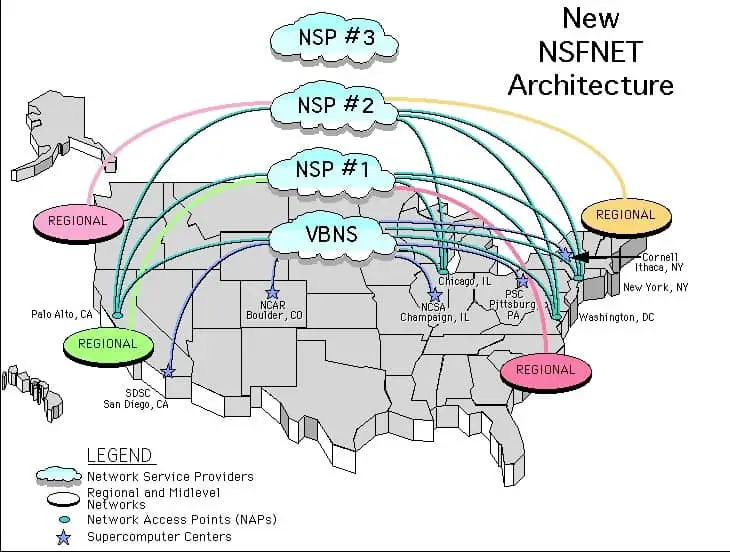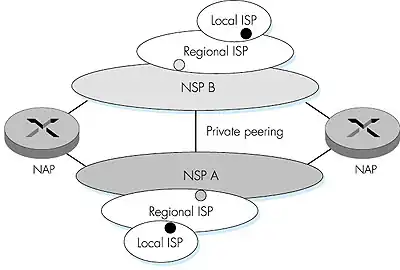A Network Access Point, or NAP, is a critical juncture in the internet’s infrastructure, functioning as the primary hub where high-speed backbone networks intersect. These points are akin to the major intersections in a highway system, directing the flow of digital traffic. At its core, a NAP is where Internet Service Providers (ISPs) connect their networks, allowing data packets to move seamlessly from one network to another. This interconnectivity is essential for the internet to operate as a unified, global entity, transcending geographical and digital boundaries.
Table of Contents:
- The Role of NAPs in Global Connectivity
- The Evolution of Network Access Points
- How NAPs Work: Technical Insights
- Major NAPs Around the World
- NAPs and Internet Service Providers (ISPs)
- Impact of NAPs on Internet Efficiency
- Conclusion
- References

1. The Role of NAPs in Global Connectivity
NAPs play a pivotal role in global internet connectivity by facilitating efficient data exchange between disparate networks. They ensure that information can travel swiftly and reliably across continents and oceans. By serving as the primary meeting points for various ISPs and network providers, NAPs not only enhance the speed and efficiency of data transfer but also contribute significantly to the resilience and robustness of the global internet infrastructure.
To lessen the traffic burden on the Internet’s backbone, major ISPs can connect their services directly to a NAP in the form of a “peering arrangement,” whereby traffic that needs to move between two ISPs connected to the same NAP can move directly from one ISP to the other instead of having to traverse the Internet’s backbone.
2. The Evolution of Network Access Points
2.1 Historical Development: From NSF’s Original Four NAPs
The concept of NAPs originated in the early 1990s with the National Science Foundation (NSF). The National Science Foundation originally established four different NAPs in Chicago, New York, San Francisco, and Washington, D.C. These NAPs marked the transition from the NSFNET, a government-funded academic network, to the commercially driven, expansive internet we know today. They were pivotal in laying the groundwork for the internet’s explosive growth by enabling more diverse and widespread network connections.

2.2 Expansion and Growth: The Emergence of New NAPs
As the internet grew, so did the need for additional NAPs. This expansion was driven by increasing data traffic and the emergence of new network technologies. Notable among the new NAPs are “MAE West” in San Jose and “MAE East” in Washington, D.C., both operated by MCI WorldCom. These additions have been instrumental in enhancing the internet’s capacity and reach, accommodating the ever-growing demand for data transmission and global connectivity.
To lessen the traffic burden on the Internet’s backbone, major ISPs can connect their services directly to a NAP in the form of a “peering arrangement,” whereby traffic that needs to move between two ISPs connected to the same NAP can move directly from one ISP to the other instead of having to traverse the Internet’s backbone.
3. How NAPs Work: Technical Insights
3.1 Understanding the Backbone of the Internet
The backbone of the Internet refers to a collection of high-speed data routes between large, strategically interconnected networks and core routers on the internet. These backbones are typically fiber-optic cables that carry vast amounts of data. Network Access Points are integral to this structure, acting as critical junctions where different ISPs and network providers interconnect their backbones, facilitating the flow of internet traffic across the globe.
3.2 The Mechanism of Traffic Exchange at NAPs
At a NAP, traffic exchange occurs when different ISPs connect their networks. This exchange is governed by peering agreements, which are mutual agreements between ISPs to exchange traffic directly through the NAP. When a user on one ISP’s network sends data to a user on another ISP’s network, the data passes through the NAP, effectively jumping from one network to another. This process is essential for maintaining the internet’s seamless, borderless nature.
3.3 High-Speed Switching Facilities Explained
The high-speed switching facilities at NAPs are akin to sophisticated traffic control systems. They use advanced networking equipment, such as routers and switches, capable of handling massive amounts of data at high speeds. These facilities are designed to efficiently manage and direct the flow of data between different networks, minimizing latency and ensuring quick, reliable transmission of information.
4. Major NAPs Around the World
4.1 Spotlight on Key NAPs: Chicago, New York, San Francisco, Washington, D.C.
- Chicago: Known for its central location, the Chicago NAP serves as a vital hub for the Midwest region, linking numerous ISPs and backbone providers.
- New York: With its proximity to major financial and business centers, the New York NAP is a key player in global data exchange.
- San Francisco and Washington, D.C.: These NAPs are strategically important due to their geographic locations, serving the West Coast and the nation’s capital, respectively.
4.2 MAE West and MAE East: The Significance of MCI WorldCom’s NAPs
- MAE West (San Jose): As one of the largest and most significant NAPs, MAE West facilitates a significant portion of the internet traffic on the West Coast, particularly for Silicon Valley.
- MAE East (Washington, D.C.): Another major NAP, MAE East, plays a crucial role in handling the internet traffic for the Eastern Seaboard.
5. NAPs and Internet Service Providers (ISPs)
5.1 The Relationship Between NAPs and ISPs
The relationship between Network Access Points (NAPs) and Internet Service Providers (ISPs) is symbiotic and essential for the functionality of the Internet. NAPs provide a physical space where ISPs can connect their networks, enabling the exchange of data across different internet service providers. This interconnection is crucial for ISPs, as it allows them to offer their customers access to the entire internet, not just the portion they directly control.

5.2 Peering Arrangements: Direct Connectivity Between ISPs
Peering arrangements at NAPs are agreements where ISPs mutually agree to exchange traffic directly with each other. This direct exchange of traffic, often without monetary exchange, is beneficial for both parties involved. It allows ISPs to bypass third-party networks, reducing latency and improving speed for data transmission. These arrangements are typically made when both ISPs have similar amounts of data to exchange, creating a balanced and efficient flow of internet traffic.
6. Impact of NAPs on Internet Efficiency
6.1 How NAPs Enhance Internet Speed and Reliability
NAPs play a critical role in enhancing the speed and reliability of the internet. By facilitating the direct transfer of data between ISPs, they reduce the need for data to travel through longer, more circuitous routes. This efficiency in data routing results in faster, more reliable internet access for end-users, reduced congestion, and improved overall network performance.
6.2 Reducing Traffic Burden on the Backbone
NAPs effectively reduce the traffic burden on the internet’s backbone. By serving as central points where ISPs can exchange data directly, NAPs alleviate the amount of data that needs to traverse the core of the internet. This decentralization of data flow helps in preventing bottlenecks, ensuring smoother and more efficient internet traffic management across the network.
7. Conclusion
Network Access Points (NAPs) are more than just intersections on the internet’s highway; they are the cornerstones of global connectivity. Acting as the critical junctures where ISPs converge, NAPs ensure the internet remains a unified, fast, and reliable network.
From the historical development of the original four NAPs to the advanced, high-speed switching facilities of today, these hubs have evolved to meet the ever-growing demands of the digital world. NAPs not only enhance the speed and efficiency of the internet but also play a vital role in ensuring its robustness and scalability.
As the backbone of the internet, they support an ever-increasing volume of data, driving the digital era forward. In essence, the seamless functioning of our global network hinges on the efficiency and effectiveness of these pivotal points of interconnection.
8. References
- “The Internet: An Introduction to New Media” by Lelia Green: Offers a broad overview of the internet’s infrastructure, including NAPs.
- “Computer Networks” by Andrew S. Tanenbaum & David J. Wetherall: Provides detailed technical insights into network architecture and NAPs.
- “Computer Networking: A Top-Down Approach” by James Kurose and Keith Ross
- “Internet Architecture: An Introduction to IP Protocols” by Uyless Black: Focuses on the architecture of the internet, with relevant discussions on NAPs.
- “Monitoring and Harmonisation of National Access Points“, European ITS Platform.